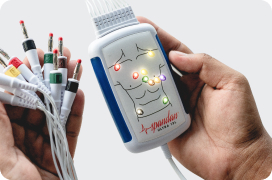
Author:- Mr. Ritesh Sharma
An ECG machine is one of the most important tools in cardiac care. Through this machine, the electrical activity of the heart can be monitored over a period of time. This device has several components, there are different types of ECG leads, ECG electrodes, and a recording device. The different types of ECG leads play a significant role in getting the test done. The electrodes are connected to these types of ECG leads and they are placed on the skin of the patients at different parts.
Through these different types of ECG leads, the electrical activity of the human heart is recorded and healthcare professionals find out if the patient has encountered any heart abnormalities.
In this blog post, we will discuss different types of ECG leads that are paramount in an electrocardiogram test. So, both healthcare professionals and general people alike will get worthy information from this blog.
Types of ECG Leads
The different types of ECG leads are mainly standard limb leads (bipolar leads), augmented limb leads (unipolar leads), precordial leads (chest leads), and additional leads. While the first three types of leads mentioned before are mandatory for a normal 12-Lead ECG test, the additional leads are only used in some specific situations. Let’s discuss all these different types of ECG leads below.
1. Standard Limb Leads (Bipolar Leads)
The standard limb leads are the original three leads used in ECG and are called bipolar leads because they measure the voltage difference between two points. These leads are:
- Lead I: Measures the electrical potential difference between the right arm (negative) and the left arm (positive).
- Lead II: Measures the electrical potential difference between the right arm (negative) and the left leg (positive).
- Lead III: Measures the electrical potential difference between the left arm (negative) and the left leg (positive).
These leads form what is known as Einthoven’s Triangle, which is a fundamental concept in electrocardiography, representing the heart’s electrical axis in the frontal plane.
2. Augmented Limb Leads (Unipolar Leads)
The augmented limb leads are unipolar leads that measure the electrical potential at one point relative to a combination of other leads. These leads are:
- aVR (augmented Vector Right): Measures the electrical activity from the right arm.
- aVL (augmented Vector Left): Measures the electrical activity from the left arm.
- aVF (augmented Vector Foot): Measures the electrical activity from the left leg or foot.
The augmented leads provide additional views of the heart’s electrical activity, especially useful for detecting changes in the frontal plane.
3. Precordial Leads (Chest Leads)
The precordial leads are unipolar leads placed on the chest to provide a detailed view of the heart’s electrical activity in the horizontal plane. There are six precordial leads, labeled V1 through V6:
- V1: Placed in the fourth intercostal space to the right of the sternum.
- V2: Placed in the fourth intercostal space to the left of the sternum.
- V3: Placed midway between V2 and V4.
- V4: Placed in the fifth intercostal space at the midclavicular line.
- V5: Placed horizontally with V4 at the anterior axillary line.
- V6: Placed horizontally with V5 at the midaxillary line.
These leads are crucial for detecting anterior, septal, and lateral myocardial infarctions, among other conditions.
4. Additional Leads
In certain clinical situations, additional leads may be used to provide further insights into the heart’s electrical activity. These include:
- Right-Sided Leads (V4R, V5R, V6R): These leads are placed similarly to V4, V5, and V6 but on the right side of the chest. They are particularly useful in diagnosing right ventricular infarction.
- Posterior Leads (V7, V8, V9): These leads are placed on the back to view the posterior wall of the heart. They are helpful in diagnosing posterior myocardial infarction.
Understanding the Views Provided by Each Lead
Each type of lead provides a different perspective of the heart’s electrical activity. Understanding these views is crucial for accurate diagnosis and interpretation.
- Limb Leads (I, II, III, aVR, aVL, aVF): These leads provide a view of the heart’s electrical activity in the frontal plane. They help assess the heart’s electrical axis and identify abnormalities such as left or right axis deviation.
- Precordial Leads (V1-V6): These leads provide a horizontal plane view of the heart. They are essential for diagnosing conditions affecting the anterior, lateral, and septal walls of the heart.
Clinical Significance
Each lead’s unique perspective allows for a comprehensive analysis of the heart’s electrical activity. Here are some clinical conditions associated with specific leads:
- Inferior Myocardial Infarction: Detected primarily in leads II, III, and aVF.
- Anterior Myocardial Infarction: Best seen in leads V1-V4.
- Lateral Myocardial Infarction: Identified in leads I, aVL, V5, and V6.
- Right Ventricular Infarction: Detected using right-sided leads such as V4R.
- Posterior Myocardial Infarction: Identified using posterior leads like V7-V9.
In conclusion, all different types of ECG leads are necessary for an electrocardiogram test. Without these leads, the screening test would not be possible and we would not get accurate results regarding several heart abnormalities. Each lead provides a unique view of the heart, enabling a comprehensive assessment of its electrical activity. By combining information from all the leads, clinicians can diagnose a wide range of cardiac conditions, ensuring timely and appropriate treatment. Whether dealing with routine check-ups or emergency situations, the knowledge of ECG leads is indispensable in the field of cardiology.




